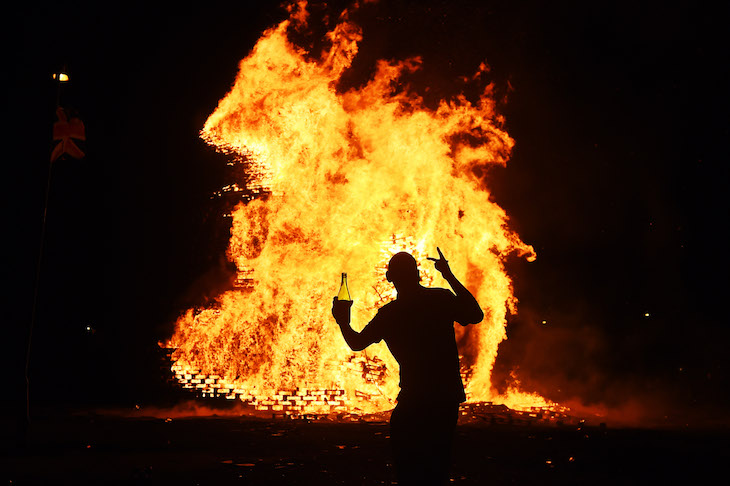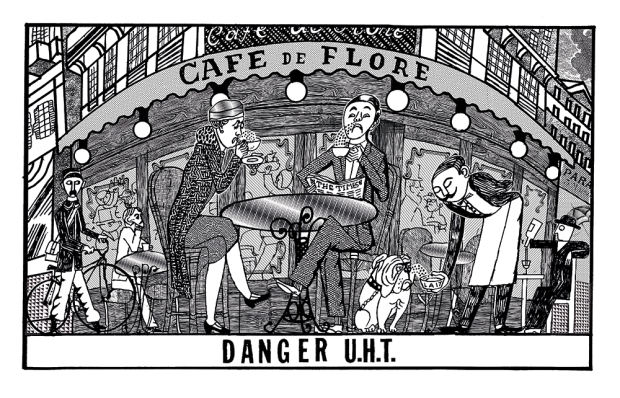Few events have appalled London liberals so publicly as the surprise emergence of the ten MPs of the Democratic Unionist Party as a force in UK politics. The metropolitan horror has been given full expression in the Twitter railing against ‘misogynist dinosaur homophobes’ and the press caricatures of DUP politicians as overfed, bowler-hatted Orangemen slyly looting government cash. Words such as ‘vile’ and ‘disgusting’ are flung around exultantly, as all nuance is shed. And beneath this lies an unspoken, potent little thrill: how wonderful, finally, to have a bunch of people whom one can openly despise.
I fear that thrill is going to intensify very soon, when images trickle in from the imminent Twelfth of July celebrations, for which energetic loyalists are even now putting the finishing touches to their towering unlit bonfires. The Twelfth is the traditional date upon which members of the Protestant Orange Order parade through the streets and lanes of Northern Ireland, accompanied by skirling pipe music and the deep boom of the Lambeg drum. They do so in celebration of the Protestant King William III’s victory over the Catholic King James II at the Battle of the Boyne in 1690 (it is one of history’s little ironies that Pope Alexander VIII was firmly on the Williamite side).
This annual display has long proved mystifying and challenging for English onlookers, for whom Northern Ireland Protestants are the least fashionable Celtic minority, and even less so when in parading mode. In recent years, however, the rites of the Twelfth have been widely ignored. Given the fresh alliances in Westminster and their irresistible opportunities for point-scoring, that will not be the case this year.
Many years ago, when first writing about the Twelfth, I used to explain to my London friends that it was not as bonkers as it seemed to them: in most places the parades were peaceful and an excuse for a family day out. The nationalist Ancient Order of Hibernians — a much smaller, Catholic version of the Orange Order — loved a pipe band and a parade too, and still do. No one from my own family was ever in the Orange Order, but when we lived in Belfast we used to walk up to watch the bands winding past the end of our road, with the rows of flautists perspiring in the summer heat, and the lipsticked teenage majorettes twirling batons. Elderly ladies brought out foldaway chairs and sat by the route with a bottle of lemonade.
Catholics often came out to watch the parades too, and in rural areas Catholic farmers might offer to keep an eye on the cattle of Protestant farmers for the day. In areas of high sectarian tension, such as Portadown, there could be a simmering volatility to events, but the modern souring of the parades really began in the mid-1990s, when — with its energies diverted by the IRA ceasefire — Sinn Fein turned in earnest to culture wars, by seeding local ‘residents’ committees’ which were often headed by former IRA members. These groups began to complain vociferously about Orange Order routes through areas which had become predominantly Catholic.
It was a strategic game of Wind-Up-The-Prods which predictably succeeded, resulting in the serial standoffs over a pre-Twelfth parade around Drumcree parish church, Portadown, thronged with angry loyalist paramilitaries who had come in to support the Orangemen’s right to march down the disputed territory of the Garvaghy Road. There were loyalist riots and outbreaks of sectarian violence. Drumcree became an annual jamboree of rage which drew the world’s cameras.
In 1997, a self-congratulatory Gerry Adams was recorded telling a Sinn Fein meeting in County Meath: ‘Ask any activist in the North, “Did Drumcree happen by accident?’’ And he will tell you, “No.” ’ Adams went on to say that ‘three years of work went into creating that situation’.
The Orangemen have been banned from walking down the Garvaghy Road for 20 years. In the decades since 1997, Adams and his team have been able to relax a little. When it comes to the Twelfth celebrations, loyalists are increasingly doing his PR work for him. The problem lies not so much in the parades themselves, the routes of which are now regulated — through fraught negotiations — by a body called the Parades Commission. Instead, the lunacy is most manifest in the preparations for the night before the Twelfth, known as the Eleventh Night, when bonfires are lit throughout Northern Ireland.
In recent years, these bonfires have become the most extraordinary structures: teetering pyres of wooden pallets, often more than 40ft tall and adorned with guys, Irish tricolours or sectarian slogans. Despite various financial inducements designed to encourage safe, inclusive and environmentally friendly fires — ‘please, no rubber tyres or sofas!’ — the phenomenon has moved decisively beyond the control of the civic authorities. In urban areas, the Unionist middle classes have increasingly stepped away from the heat. Last year, a giant bonfire in the working-class Shankill area of Belfast gutted two nearby houses. This year it emerged that officials at Belfast City Council had agreed to store 3,000 bonfire pallets on council premises in advance of the Twelfth — they were mysteriously stolen. In East Belfast, some busy youths have unilaterally closed off a public car park and built a gigantic pyre there instead. When one wan lad was interviewed about his right to annex the area, he said: ‘It’s part of our culture.’
Can bonfires be part of cultural expression? Certainly they can. But when they are enormous fires built in unauthorised areas, blazing near housing and belching out poisonous smoke, they are no longer expressions of a culture but of a psychological condition. That condition is one of defiance and despair among working-class Protestants, who feel abandoned by the rest of the UK. Something about the intricate engineering of those pyres, the relentless industry that goes into them, is inherently sorrowful. Once their ancestors employed just such talents in a thriving shipyard that dispatched great vessels all across the world. Now they are directed into piles of ash on scorched earth.
Yet the sheer scale of these displays also speaks of the sway held by former loyalist paramilitaries. Back in the 1990s, in the formative stages of the peace process, I used to wonder out loud what the effect of allowing IRA and loyalist paramilitaries into the heart of politics would be. In the long term either the paramilitaries would be converted to democracy, I said, or they would gradually corrupt it. I suspected the latter. Among the folk who had been beckoned into political life were not only ruthless members of the IRA Army Council, but also loyalists such as John White of the newly formed Ulster Democratic Party, formerly of the UDA, who had frenziedly stabbed to death the nationalist Senator Paddy Wilson and his friend Irene Andrews.
The British government’s thinking, however, was that if you funnelled enough cash into transforming former terrorists into politicians and community workers, you could keep their violent tendencies in check until peace took root and a new generation rose up to replace them. As late as 2015 Jonathan Powell was in Belfast to just that end, helping to set up the ‘Loyalist Communities Council’ with representatives of the UDA and the UVF. To some extent that strategy has been effective, but it has one great flaw: entrenched in communities, generously funded, and freed from official censure, veteran paramilitaries are increasingly regarding their brutal histories with warmly sentimental rather than shame-filled eyes.
They are all apt to glorify their ‘war’ with scant regard for the victims. In the recent election campaign, for example, Sinn Fein thought it a perfectly good idea to send Sean Kelly out canvassing, knocking on doors: in 1993, Kelly set off the Shankill bomb, which killed nine Protestant civilians in a fish shop. In South Belfast recently, there was a sudden proliferation of UVF flags flying from lamp-posts near a shared housing estate. The sectar-ian murders of blameless Catholics by the UVF during the Troubles were legion, yet the new DUP MP, Emma Little–Pengelly, responded limply to concerns by saying that the majority of people ‘didn’t want a public fuss around this matter’. As they say in mafia-controlled areas in Sicily: I wonder why so many locals might want to keep their heads down?
The DUP might look across at Sinn Fein — with its endless, gloating public IRA commemorations — and wonder why, on questions of sectarianism, it should behave any better. Yet it is now not only the largest Unionist party in Northern Ireland — representing many Unionists who intensely dislike paramilitarism — but is also closely involved in the government of the UK. Tribes can be tricky things to navigate, but if the DUP doesn’t soon show decisive leadership in facing down the flags, the fires and the casual glorification of paramilitary horrors, its own reputation will be devoured by it. What Northern Ireland needs now is not the wrong kind of culture, but the right kind of courage. And English onlookers might just want to help foster it, instead of warming their criticisms on the blaze.
Jenny McCartney is joined from Belfast by Siobhan Fenton on The Spectator Podcast.
Got something to add? Join the discussion and comment below.
Get 10 issues for just $10
Subscribe to The Spectator Australia today for the next 10 magazine issues, plus full online access, for just $10.
You might disagree with half of it, but you’ll enjoy reading all of it. Try your first month for free, then just $2 a week for the remainder of your first year.















Comments
Don't miss out
Join the conversation with other Spectator Australia readers. Subscribe to leave a comment.
SUBSCRIBEAlready a subscriber? Log in